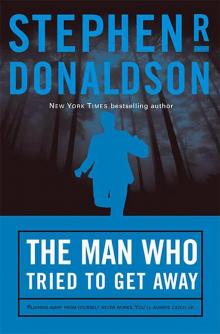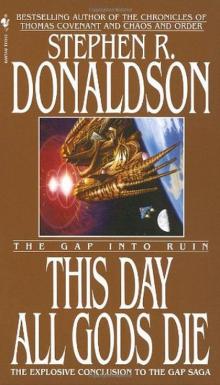- Home
- Stephen R. Donaldson
Chaos and Order: The Gap Into Madness Page 5
Chaos and Order: The Gap Into Madness Read online
Page 5
The name of that illegal vessel had been Gutbuster.
And Gutbuster’s file held a mine of potential connections.
For example, Hashi read, Gutbuster was the vessel which had killed the original Captain’s Fancy, leaving only one survivor aboard, her cabin boy, Nick Succorso.
And she was the vessel which had once damaged the UMCP cruiser Intransigent, commanded by Captain Davies Hyland. His wife, Bryony Hyland, Morn’s mother, had died in the fight.
According to Intransigent’s records, Gutbuster carried super-light proton cannon. That was almost unprecedented for an illegal vessel: the expense of such guns, both in credit and in power consumption, was prohibitive.
On the other hand, she had no gap capability.
Which explained her five-year hiatus from action. In order to survive, she’d limped to a bootleg shipyard—or perhaps into forbidden space—to retrofit a gap drive.
That, in turn, accounted for the subtle, but unquestionable discrepancies between Gutbuster’s known and Soar’s recorded emission signatures and scan profiles.
Hashi was tempted to postpone other, more urgent matters for a while: just long enough to issue a commendation for the tech who’d compiled this report. He had no time for such luxuries, however. Strange and unquantifiable ideas spun through his head as if they could hardly be contained by the mere bones of his skull or the walls of his office. If the facts and suggestions he’d gleaned were as evanescent as quarks—micro-events with little more than a theoretical reality—they nevertheless partook of subatomic energies potent enough to produce thermonuclear detonations and core meltdowns.
Caught in a whirl of exhilaration and terror, he snatched off his glasses and covered his eyes with his hands, not to prevent vision from entering in, but rather to keep an electron storm of potentialities from escaping.
Kazes had attacked the GCES and UMCPHQ, using legitimate id made from UMCP SOD-CMOS chips.
Kazes are such fun, don’t you think?
Captain Vertigus proposed to introduce a Bill of Severance. He feared threats against the UMCP Director of Protocol.
Morn Hyland and Nick Succorso had in common a connection with Soar née Gutbuster—a vessel which just happened to be present at Thanatos Minor when both they and Joshua arrived there. A vessel which Morn had good reason to hate, but to which Nick might be linked by bonds of another kind.
And Hashi was under no illusions about the nature of the relationship between Nick and Morn. Whatever she may have felt toward him, he was capable of nothing but exploitation.
You deserve her.
But that wasn’t all. Certainly not.
Darrin Scroyle’s people had heard rumors of an antimutagen for sale from Soar’s captain, Sorus Chatelaine.
Nick was presumably the only man in that quadrant of space with a mutagen immunity drug in his possession—the only man from whom Sorus Chatelaine might have obtained an antimutagen.
He’d been seen talking to Joshua and Milos Taverner.
And he’d brought a cargo of some kind from Enablement Station: a cargo which he’d sent by ejection pod to Billingate to prevent the Amnion from reclaiming it: a cargo which someone had subsequently stolen.
Later Nick was rumored to have sold one of his people to the alien sector on Thanatos Minor. Then that sector had been raided by an EVA team from Trumpet. Captain’s Fancy had rammed an Amnion warship and died in order to keep the raiding team alive.
Nick no longer had a ship. Yet he must have rescued something. Something more valuable to him than his frigate.
If you can get her, you bastard, you can have her.
Reality itself seemed to be in flux as Hashi Lebwohl rode coriolus forces around and around inside his head. Micro-events remapped the macro-world. If he’d been under less pressure, he might have paused to notice that he enjoyed this sensation; that he felt more alive at moments like this than at any other time.
The pressure to act was real, however; ineluctable despite the uncertainty of its cartography. Yet action was impossible until some manner of readable map, no matter how intuitive or speculative, had been obtained.
He needed to understand.
Very well, he told himself. Construct a hypothesis and explore its implications. Theoretical reality is better than no reality at all.
Clamping his hands harder over his eyes, he began.
He wasn’t prepared to guess who’d sent kazes against Sixten Vertigus and Godsen Frik. That ground was too dangerous: he didn’t mean to walk it until he was sure of each step. But he was quite ready to hazard other speculations—
When he did so, his thin heart nearly stopped.
Kazes are such fun, don’t you think?
Suppose for the moment that Nick Succorso and Sorus Chatelaine were working together; that they’d conceived a plan to bring themselves almost limitless wealth. And suppose, further, that Morn Hyland had opposed them, inspired by her old enmity toward Gutbuster, if not by loyalty to the UMCP. Suppose that they’d decided to rid themselves of her, and to greatly increase their opportunities for wealth, by producing and then selling the DA immunity drug under circumstances designed to terrify the population of human space.
According to this hypothesis, Nick had taken Morn to Enablement so that the Amnion could make use of her—perhaps by transforming her into some manner of genetic kaze aimed at UMCPHQ itself. After that everything he, Sorus, and the Amnion did had been part of an elaborate charade.
Hashi reconstructed the charade in his mind, even though it made him tremble.
The Amnion had pursued Captain’s Fancy to Billingate in order to create the illusion that they wished to stop Nick and Morn. To confirm that impression, Nick had sent her to the Bill in an ejection pod. From Joshua and Milos Taverner, Nick had learned what had brought a UMCP cyborg to Thanatos Minor. Then he and his partner, Captain Chatelaine, had begun the rumors that she possessed an antimutagen.
To demonstrate the efficacy of her drug, as well as to reinforce the impression that he was bargaining in order to save his own life, he’d given Morn back to the Amnion. With their connivance, he’d retrieved her again. After that, he’d tricked his way aboard Trumpet, perhaps with Milos Taverner’s aid.
Hashi’s pulse pounded in his head; in his eyes. He rode a mad swirl of phosphenes and alarm. His hypothesis was self-consistent. It fit the available data. It could be true.
If Nick succeeded at putting her aboard the gap scout, Morn would survive to wreak mutagenic ruin on the UMCP. And the knowledge that Sorus Chatelaine had obtained an immunity drug would spread. It was spreading even now. Genetic kazes were the stuff of nightmare—the worst horror visceral human DNA could imagine. Driven by panic, humankind would offer her every kind and scale of riches in self-defense.
You deserve her.
Nick had sent his message to Hashi as a taunt, trusting that no cop would be able to guess the dark truth. Of course, his plan would fail if the UMCP themselves made the drug available. But they could hardly do so when a genetic kaze had gone off in their faces—when they were being torn apart by self-replicating alien nucleotides.
Shivering in an ague of speculation, Hashi strove to fault his hypothesis.
I don’t care what happens to you.
Was it possible? That was the essential question: every other concern faded to vapor by comparison. Could Joshua be tricked or maneuvered into keeping Morn alive?
He had no orders to preserve her life. Quite the reverse. On the other hand, she was UMCP personnel. Therefore he couldn’t kill her himself: his programming protected all UMCP personnel from direct violence. What if she were forced on him in some way?—for example, if her survival was the price he had to pay for the success of his mission? What then?
Under those conditions, Hashi acknowledged feverishly, Joshua’s datacore would not preclude her rescue.
And the information she carried within her was as destructive as any mutagen. Quite apart from other possibilities, it could ruin Warden Dios and
all his senior personnel; perhaps end their lives; quite conceivably destroy the UMCP itself.
Supposition proved nothing. Nevertheless Hashi suddenly found it not only possible but credible to think that Morn Hyland might still be alive.
Lethal! his covert mind shouted at him. Deadly! Such a development would be fatal—entirely fatal.
You need me, but you blew it.
Perhaps he’d misjudged the depth of Nick Succorso’s malice.
Abruptly he dropped his hands from his face to his board. Their pressure against his eyeballs left his vision blurred; but he didn’t need clear sight to hit the keys he wanted.
Perhaps he’d been more honest with Koina Hannish than he wished to admit when he’d spoken of loyalty. Whatever the reason, he didn’t question his decision once it was made. He’d been passive too long. Instead of hesitating further, he prepared a new contract for Captain Scroyle and flared it out to the same listening post which Free Lunch had used to contact him.
It was the richest contract he’d ever offered a mercenary; a king’s ransom in exchange for Trumpet’s destruction and the death of everyone aboard.
The mere act of coding that message filled him with an inexpressible sense of conscious alarm and intuitive relief. The risk he took was extreme. Nevertheless, directly or indirectly, he’d created the threat Nick represented. He’d hired Nick. More than once. He was responsible for the danger.
As soon as his transmission was on its way, Hashi Lebwohl left his office and went looking for Warden Dios. The walk would allow him a chance to recover his composure. And he wanted to report in person so that he could more easily give his director an edited version of what he’d learned.
What followed then would enable him to refine his speculations. In addition, it would reinforce or undermine his impression of Warden Dios as a man who lived in the world of the real.
ANCILLARY
DOCUMENTATION
GAP TRAVEL
The “Juanita Estevez Mass Transmission Field Generator,” almost exclusively known as the “gap drive,” was a revolutionary discovery. It virtually recreated the future of humankind. The frontiers of human space were immediately and profoundly altered. Access to desperately needed new resources, combined with the simultaneous wealth and hazard of commerce with the Amnion, ended a prolonged period of economic deterioration. Instead of being constricted by poverty and the sun’s gravity well, the horizons were now limited only by the velocity of human ships, the power of human gap field generators, and the scope of human imaginations. In a sense, the entire galaxy of the Milky Way now lay within reach.
However, some of the gap drive’s effects were more subtle. For example, it produced an insidious distortion in the perception of real space. The ability to travel imponderable distances almost instantly created the pervasive illusion that those distances were indeed effectively small. The entire galaxy of the Milky Way now lay within reach. The implications of such a statement were at once mind-numbing and misleading. In the crude spiral of the Milky Way, Earth’s approximate distance from galactic center was 26.1×1016 kilometers: 2,610,000,000,000,000,000 k. A ship traveling at a velocity of .5c would take roughly fifty-five thousand years to reach galactic center. At the speed of light, the trip would still take 27,500 years. Taken at an arbitrary average, human ships could cross ten light-years with every gap crossing. Even at that rate, 2,750 crossings would be required to cover the distance.
Being what they were, however, human beings found 2,750 a conceivable number. Therefore the space between Earth and the center of the Milky Way became conceivable.
The fallacy in all this was so subtle that most people failed to notice it.
In real time, effective time, the light-years crossed by the gap drive didn’t exist. A ship with a gap drive didn’t travel those light-years: it bypassed them through dimensional translocation. But when the crossing was done, the ship returned to normal space—and normal space was so vast that its scale was not truly conceivable.
Most people thought, So what? The gap drive did exist. The only real time involved in travel was taken up by acceleration to attain the necessary velocity and then by deceleration at the other end. Amnion space was just a few days away at the best of times.
True: Amnion space was just a few days away in a gap ship. And communication was equally fast: messages conveyed by ship could arrive centuries or millennia ahead of any speed-of-light transmission. But neither space nor time had meaning in the strange physics of the dimensional gap. Ships didn’t encounter each other there: they didn’t communicate or exchange shipments; they didn’t do battle or give chase. Every action of any kind, human or Amnion, took place in normal space, at space-normal speeds. And at space-normal speeds even the nearest stars were pragmatically out of reach.
In other words, the discovery of the Juanita Estevez Mass Transmission Field Generator had a transforming effect on humankind’s relationship with vast distances—and no effect at all on humankind’s place in normal space.
The dilemma of piracy was a case in point.
Why was piracy such a virulent problem? How had it attained such power in human space? Ships could cross the gap in a matter of instants. If a pirate raided, say, Terminus, the information could be transmitted to Earth by gap courier drone, and within hours UMCPHQ could send out a cruiser to support the station. How could any illegal flourish under these conditions?
Quite simply, piracy flourished because it took place in normal space. Like the UMCP, illegals often had gap ships. Nevertheless their every action took place in normal space. Gap ships could change the sector of space in which they acted with incredible ease; but the actions themselves still consumed real time and involved real distances. A UMCP cruiser might well chase a pirate vessel across the entire galaxy—and yet every effort the cruiser made to give battle occurred in normal space, where simply hunting through a solar system for telltale emissions was a job that might take months.
These hindrances were vastly increased by the fact that gap travel itself was not as precise as it appeared on paper. Both course and distance for any crossing were susceptible to several forms of inaccuracy. Minuscule fractions of a degree in course became hundreds of thousands of kilometers when those fractions were multiplied by light-years. And the calibration of distance was even more complex. The distance a ship traveled through the gap varied according to a number of factors, including speed, rate of acceleration, and the ratio between her mass and both the actual and potential power of her gap drive.
In addition the interaction of those elements was ruled by the gap drive’s hysteresis transducer, which controlled the extent to which the drive’s effect lagged behind its cause: too much lag, and the ship never went into tach; too little, and the ship never resumed tard. As a result, tiny fluctuations in power or hysteresis, or minute miscalculations of mass, became large shortfalls or overshots. Superhuman precision was required to make any ship resume tard right where her captain intended when he went into tach.
For that reason—and because ships came out of the gap with all the velocity their crossing demanded—Earth required the solar system’s massive non-UMCP traffic to use a gap range beyond the orbit of the last planet; and ships approaching any station were expected to resume tard well outside the sphere of that station’s control space.
Here again the sheer scale of space subtly undermined humankind’s apparent mastery of inconceivable distances. Being a pirate was easier—and fighting piracy was harder—than most people understood.
SORUS
Soar survived because her captain, Sorus Chatelaine, had been forewarned.
The Amnion shuttle’s passengers had warned her, of course. She’d saved the small craft after it was thrown off course and out of control by the repercussions of her brief, one-sided fight with Captain’s Fancy. The shuttle’s passengers were aboard now: they stood in front of her on Soar’s bridge, talking to her—and to Calm Horizons—constantly. They told her what they could about the att
ack on the Amnion sector; about the rescue of Morn Hyland; about the powers and exigencies which had come into conflict on the planetoid.
But that information might not have been enough to preserve Soar. It arrived perilously late. Fortunately Sorus had been forewarned in other ways. The damage to Billingate communications showed her that the installation was in trouble—and she knew how to jump to the kinds of conclusions which kept ships and illegals alive.
Captain’s Fancy should have been under Calm Horizons’ control. The Amnion had Nick Succorso’s priority-codes—and Succorso himself wasn’t aboard his ship to countermand them. The Amnion should have been able to take effective command of the frigate. In fact, his ship had given every sign that she was indeed responding to those codes; submitting to Calm Horizons’ instructions. Nevertheless her subsequent, suicidal attack on Tranquil Hegemony demonstrated that her submission had been a ruse.
The codes were false. Perhaps they’d never been true. Or perhaps they’d been changed recently. In either case, it was clear that Captain’s Fancy had feigned helplessness, not in order to prepare an attack on Soar—as Sorus had assumed—but rather to defend the raiding party from Trumpet which had entered the Amnion sector.
In other words, events weren’t moving as the Amnion wanted—or predicted. The understandings which they’d shared with her prior to the arrival of the shuttle’s passengers were inaccurate. And Trumpet was behaving no more predictably than Captain’s Fancy.
Such things forewarned Sorus before Milos Taverner told her what he knew of the danger. By the time Calm Horizons ordered her to the warship’s support against Trumpet, she’d already rigged her ship for battle or collision, and had begun putting distance between herself and Thanatos Minor.

 The Illearth War
The Illearth War Last Chronicles of Thomas Covenant 02 - Fatal Revenant
Last Chronicles of Thomas Covenant 02 - Fatal Revenant Lord Foul's Bane
Lord Foul's Bane The Gap Into Ruin: This Day All Gods Die
The Gap Into Ruin: This Day All Gods Die White Gold Wielder
White Gold Wielder Fatal Revenant
Fatal Revenant The Mirror of Her Dreams
The Mirror of Her Dreams Against All Things Ending
Against All Things Ending The Real Story: The Gap Into Conflict
The Real Story: The Gap Into Conflict The Power That Preserves
The Power That Preserves Seventh Decimate
Seventh Decimate The Gap Into Power: A Dark and Hungry God Arises
The Gap Into Power: A Dark and Hungry God Arises A Man Rides Through
A Man Rides Through The Gap Into Vision: Forbidden Knowledge
The Gap Into Vision: Forbidden Knowledge The King's Justice: Two Novellas
The King's Justice: Two Novellas The Wounded Land
The Wounded Land The Runes of the Earth
The Runes of the Earth Mordant's Need
Mordant's Need The One Tree
The One Tree Gilden-Fire
Gilden-Fire Reave the Just and Other Tales
Reave the Just and Other Tales The Man Who Fought Alone
The Man Who Fought Alone The Last Dark
The Last Dark The Man Who Tried to Get Away
The Man Who Tried to Get Away Thomas Covenant 02: The Illearth War
Thomas Covenant 02: The Illearth War A Dark and Hungry God Arises
A Dark and Hungry God Arises The One Tree t2cotc-2
The One Tree t2cotc-2 Lord Foul's Bane cotc-1
Lord Foul's Bane cotc-1 The Illearth War t1cotc-2
The Illearth War t1cotc-2 The Runes of the Earth: The Last Chronicles of Thomas Covenant - Book One
The Runes of the Earth: The Last Chronicles of Thomas Covenant - Book One The King's Justice
The King's Justice White Gold Wielder t2cotc-3
White Gold Wielder t2cotc-3 The Power That Preserves t1cotc-3
The Power That Preserves t1cotc-3 Thomas Covenant 01: Lord Foul's Bane
Thomas Covenant 01: Lord Foul's Bane Chaos and Order: The Gap Into Madness
Chaos and Order: The Gap Into Madness Daughter of Regals
Daughter of Regals Forbidden Knowledge: The Gap Into Vision
Forbidden Knowledge: The Gap Into Vision Fatal Revenant t3cotc-2
Fatal Revenant t3cotc-2 The Runes of the Earth t3cotc-1
The Runes of the Earth t3cotc-1 Thomas Covenant 03: Power That Preserves
Thomas Covenant 03: Power That Preserves This Day all Gods Die: The Gap into Ruin
This Day all Gods Die: The Gap into Ruin The Wounded Land t2cotc-1
The Wounded Land t2cotc-1 This Day All Gods Die
This Day All Gods Die One Tree
One Tree